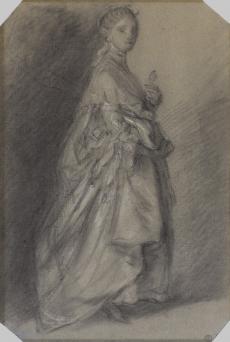


John Hayes does not appear to have seen the drawing but, on the strength of the provenance, Richard James Lane’s lithograph and the illustration in the 1955 sale catalogue, he included the sheet in his catalogue raisonné. He misread the object in the sitter’s left hand as a vase, an oddly classical devise for Gainsborough to choose, but closer inspection shows that she is holding a rose sprig, a detail that appears in many of his formal painted portraits. The sitter is shown in a saqueback dress, the train held over her right arm, with lace engageantes at the elbow, a gauze fichu around her shoulders, roundel earrings and a pendant held by a ribbon. She wears a cap and perhaps a pompon. Her hair is dressed in a style described by contemporaries as tête de mouton, which was fashionable for a short time in the mid-1760s.
Hayes linked the drawing to the pose of Lady Egremont in a portrait by Gainsborough at Petworth House, West Sussex, which, according to an unpublished letter, dates from 1765. Excepting the head and hair, the portrait and the background have been completely repainted, though the pose of Gainsborough’s original portrait was probably retained.
If this is the case, the design follows compositions in several three-quarter-length portraits by Gainsborough that derive from the portrait of Lady Mary Villiers standing in the foreground of Sir Anthony van Dyck’s huge portrait of the Pembroke Family (Wilton House, Wiltshire). It is not known who repainted Gainsborough’s portrait, though the most likely candidate is Thomas Phillips, who was a close associate of George Wyndham, 3rd Earl of Egremont, the sitter’s son.
Gainsborough’s figure studies are rare. Most of his drawings are of landscape subjects made during walks in the countryside and, as he became increasingly short of time due to his popularity as a portraitist, he drew as a relaxation at home. Although Gainsborough never sold a drawing, he is known to have given some landscape studies away as gifts; the majority of his figure studies remained in his studio. Some are related to portraits painted in the early 1760s, when his portrait style was changing rapidly and he needed to experiment on paper before committing his ideas to canvas. Gainsborough’s extant figure studies did not appear in his studio sale or in the auction sales that were held during the 1790s by Gainsborough’s widow and his nephew and studio assistant, Gainsborough Dupont (1754-1797). Instead, they were ‘reserved by the late Miss Gainsborough as favourite studies of her Father’ and, as the missing corners suggest, were stuck into an album. The artist’s elder daughter, Mary (1748-1826), was increasingly deluded in her later years, and after the death of her sister Margaret (1752-1820), her cousin, Sophia Lane (1762-1846), cared for her. The album of drawings either passed to a local well-wisher, Henry Briggs (1787-1854), whose motives are difficult to determine, or to Sophia’s son, Richard James Lane (1800-1872). Lane made lithographs of the best of the sheets, including this drawing, and they were published in book form by J. Dickinson in London in 1825 under the title Studies of Figures by Gainsborough: Executed in Exact Imitation of the Originals. Their competence served Lane well, and he was elected as an Associate of the Royal Academy two years later.
Along with his rival, Sir Joshua Reynolds, he was the leading portrait painter of his generation and one of the creators of the 18th-century British landscape school. He had a precocious talent for drawing and, aged 13, moved to London to study with Gravelot. By 1759 he was living in Bath, where he attracted a fashionable clientele, whom he portrayed in stylish, contemporary dress. In 1769 he was a founder-member of the Royal Academy, with which he subsequently fell out. Living in London from 1774, he received, from 1780 on, many royal commissions for portraits; his own preference was for landscape. His only known assistant was his nephew, Gainsborough Dupont.